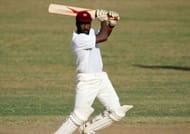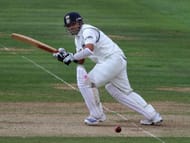The first ever ODI was played in 1971 between Australia and England, as a last-ditch attempt to get a result from a rain-affected Test match. The aftermath of this would lead to the birth of an engrossing format and further down the line, the World Cup.
Unlike Test cricket, there’s no batsman who's hands down above everyone else in ODIs. That allows the debate to rage on - who’s the greatest of them all?
Most people would agree that Sir Viv Richards, Sachin Tendulkar, Virat Kohli and AB de Villiers would be premier contenders for the prestigious distinction. But once you look at these four, the difficulty in comparisons starts to surface. The nuances of cricket make it extremely difficult if not impossible, to fairly compare players across generations.
The closest we can come to doing a fair evaluation is to compare these players to the best players from their respective generations and measure the gulf to determine the best. The reason I've chosen Richards and Tendulkar for this comparison is that they've both played in bygone eras; bringing Kohli and De Villiers into this would be a question for another day, as their generation is still ongoing.
Sir Vivian Richards

The name Viv Richards would often strike fear into the hearts of the best contemporary bowlers, and for good reason. In an era notorious for the lack of helmets and the emergence of some of the greatest bowlers to have graced the game, Richards stood out like a beacon and thrived against what his peers dreaded.
His numbers speak for themselves and look thoroughly impressive, even as of now in 2018. But the sheer magnitude of those numbers really starts to sink in when you compare them to the next best few from his era (criteria for best are players who scored at least 3000 runs in the time period and played for a majority of the time period).

Richards has the highest average comfortably, but what makes his numbers outstanding is the strike rate. The six next best batsmen have an average strike rate of 69.09 and a mean average of 40.44 (though it is to be noted that the average takes a hit due to Allan Border's numbers).
Still, it is quite a staggering difference.
To put it in perspective, the increase in strike rate is a massive 23.6% and the increase in average is 14% over the mean for top players. To give these numbers some more context, we have to combine the average and strike rate (which is done by multiplying the average by runs per ball).
When this is done, Richards' numbers turn out to be 42.23, whereas the average for the next best six is 27.86. Border's numbers once again skew the combined average slightly, so if we exclude his numbers the average still turns out to be 29, which is 32% less than Richards' numbers.
That essentially means Richards' numbers were 32% better than the next few best batsmen he played with.
Sachin Tendulkar

Undoubtedly, Sachin Tendulkar is among the greatest to have ever played the game and arguably the most iconic player to have played for India. Tendulkar's numbers are phenomenal in ODIs, especially considering the longevity and the two highly contrasting eras he played in. That makes the debate even more interesting and difficult to conclude.
Tendulkar made his ODI debut in 1989 and played his last game in 2012. This is a massive career span of 23 years, so to fairly evaluate his prolific career, we have to split it up.
If we only consider the 90s (1990-1999), then Tendulkar is comfortably the best player when compared to the other top contemporaries. In this period Tendulkar scored 8571 runs at an average of 43.07 and a strike rate of 86.81.
Using the same criteria for the best players, if we do the same as we did with Richards and compare these numbers to the numbers of the next six best batsmen, this is what the table looks like.

In this case Brian Lara, Mark Waugh, Saeed Anwar, Sourav Ganguly, Michael Bevan and Inzamam Ul Haq have been considered. The mean average of their numbers comes out to be 44.21, which is marginally higher than Tendulkar's average, and the mean strike rate is 76.72.
This means that Tendulkar was nearly on par with other top batsmen, and was striking at a considerably better rate. Now if we do the same as we did for Richards and multiply the average by runs/ball, Tendulkar's numbers are 37.39 whereas the rest of them have an average weighted score of 33.92.
That makes him almost a whole 10% better than the rest of the top players. While that is very impressive on its own merit, the numbers would be even better if we remove Bevan from the equation due to the large number of not-outs.
This, however, was just in the 90s. What about the rest of his career?
From 2000 to 2009 Tendulkar averaged 46.68 and had a strike rate of 85.04. These numbers are again, very good. I've chosen this criterion because that was Tendulkar's peak and also was the time when the era was on the verge of another massive change.
If we do the same exercise that we did before and take the next six best batsmen who are Ricky Ponting, Jacques Kallis, Chris Gayle, Yuvraj Singh, Adam Gilchrist and Herschelle Gibbs, this is what the comparison looks like.

The mean batting average for them is 40.66 and the mean strike rate is 86.05. Once again, when we combine the average and strike rate, Tendulkar's numbers are 39.69 whereas the mean for the others is 34.72, which means that Tendulkar in the 2000s was 12.4% better than the top batsmen of the 2000s.
Other factors to consider
While the numbers would suggest that Richards is significantly better than Tendulkar, we also need to consider how long they both dominated for. Tendulkar played for 23 years; while this comparison only includes 20 years of his career, he still played almost 120 ODIs more than Richards in that time period.
Another even bigger factor to consider was that there was no method of analyzing technique when Richards was playing, which allowed him to mask his weaknesses.
A point in favour of Richards would be that he played in a period where everyone was absolutely terrified of fast bowling except for him; it was the infamous era of no helmets and unprotected wickets. This is the major reason why people rate Richards so highly, due to the fringe conditions he played in.
Both Richards and Tendulkar are legends of the game, both of them are ODI all-time greats. The numbers would suggest that Richards is better than Tendulkar, but when you look beyond the static numbers, one could make a very convincing argument for either of them being the greatest of all time.
Follow IPL Auction 2025 Live Updates, News & Biddings at Sportskeeda. Get the fastest updates on Mega-Auction and cricket news
